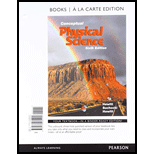
How many electrons can occupy the first shell? How many can occupy the second shell?
The number of electrons that can occupy first shell and second shell.
Answer to Problem 1RCQ
Solution:
Two electrons can occupy the first shell and eight electrons can occupy the second shell.
Explanation of Solution
In structure of Atom, electrons are found inside the shells. The shells represents the primary energy levels of an atom. Each shell has a set of sub-shells which represents various energy levels of the shells. Each sub-shell (except s-subshell) has further divided on the basis of energy levels – which are called “orbitals”.
Quantum numbers illustrates the possible energy levels and sub-energy levels of an atom. The four types of quantum numbers are – Principal quantum number, Angular quantum number, Magnetic quantum number and Spin quantum number.
Principal quantum number correlates to the possible number of shells in an atom. It is designated as ‘n’. The shells are represented as numerical positive integers 1, 2, 3, etc or alphabetically – K, L, M, N etc.
Angular quantum number gives the energy levels within the shell – which is also known as sub-shells. It also represents the shape of the sub-shells. Accordingly K-shell has only one sub-shell termed as‘s’. L-subshell has 2 sub-shells that are‘s’ and ‘p’. M-shell has 3 sub-shells that are termed as‘s’, ‘p’ and‘d’ and so on.
Magnetic quantum number explains about the possible energy levels of the sub-shells. They are called “orbitals”.
Spin quantum number represents the spin of the electron that occupy in the orbital.
According to Aufbau’s principle, electrons are occupied from the lowest energy level to highest energy level.
According to Hund’s rule, electrons are singly occupied in all the orbitals of the sub-shells and all those electrons have parallel spin. After the electrons are singly occupied, electrons further occupy the singly filled orbitals with opposite spin. This relates to Pauli’s exclusion principle which states an orbital can have only two electrons which must have opposite spins with respect to each other.
Each orbital can accommodate two electrons of opposite spins. The first shell has one s-orbital and 2 electrons are occupied in it. The second shell has 2 sub-shells – s and p. Six electrons are occupied in the 3 p-orbitals as two electrons per p-orbital. Further the p-subshell also has an s-orbital and 2 electrons can be occupied there. Totally 8 electrons can occupy the second shell.
Conclusion:
The number of electrons that can occupy first shell and second shell have been determined
Want to see more full solutions like this?
Chapter 15 Solutions
Conceptual Physical Science, Books a la Carte Edition; Modified Mastering Physics with Pearson eText -- ValuePack Access Card -- for Conceptual Physical Science (6th Edition)
Additional Science Textbook Solutions
Anatomy & Physiology (6th Edition)
Chemistry: Structure and Properties (2nd Edition)
Genetic Analysis: An Integrated Approach (3rd Edition)
Microbiology with Diseases by Body System (5th Edition)
Chemistry: An Introduction to General, Organic, and Biological Chemistry (13th Edition)
Physics for Scientists and Engineers: A Strategic Approach, Vol. 1 (Chs 1-21) (4th Edition)
- 4a Which of the following values COULD NOT be a magnitude? Choose all that apply. 626 0 -0.806 8.63 -48.5 72 131 156 4b Px = -1248 & Py = 261. Determine P.P = Qx = -1540 & Qy = 375. Determine Q.Q = 4c. T = 1105 & Ty = 425. Determine the two possible values for Tx. 4d. Uy = -38. Which of the following COULD NOT be the value of U? Choose all that apply. 10 70 72 31 47 0 75 38 4e. R has a magnitude of 165. Which of the following COULD be Rx? Choose all that apply. 165 -171 155 0 -156 -165 172 -130arrow_forward9.arrow_forward10.arrow_forward
 University Physics Volume 3PhysicsISBN:9781938168185Author:William Moebs, Jeff SannyPublisher:OpenStax
University Physics Volume 3PhysicsISBN:9781938168185Author:William Moebs, Jeff SannyPublisher:OpenStax
 Stars and Galaxies (MindTap Course List)PhysicsISBN:9781337399944Author:Michael A. SeedsPublisher:Cengage Learning
Stars and Galaxies (MindTap Course List)PhysicsISBN:9781337399944Author:Michael A. SeedsPublisher:Cengage Learning Foundations of Astronomy (MindTap Course List)PhysicsISBN:9781337399920Author:Michael A. Seeds, Dana BackmanPublisher:Cengage Learning
Foundations of Astronomy (MindTap Course List)PhysicsISBN:9781337399920Author:Michael A. Seeds, Dana BackmanPublisher:Cengage Learning Modern PhysicsPhysicsISBN:9781111794378Author:Raymond A. Serway, Clement J. Moses, Curt A. MoyerPublisher:Cengage Learning
Modern PhysicsPhysicsISBN:9781111794378Author:Raymond A. Serway, Clement J. Moses, Curt A. MoyerPublisher:Cengage Learning Physics for Scientists and Engineers: Foundations...PhysicsISBN:9781133939146Author:Katz, Debora M.Publisher:Cengage Learning
Physics for Scientists and Engineers: Foundations...PhysicsISBN:9781133939146Author:Katz, Debora M.Publisher:Cengage Learning





